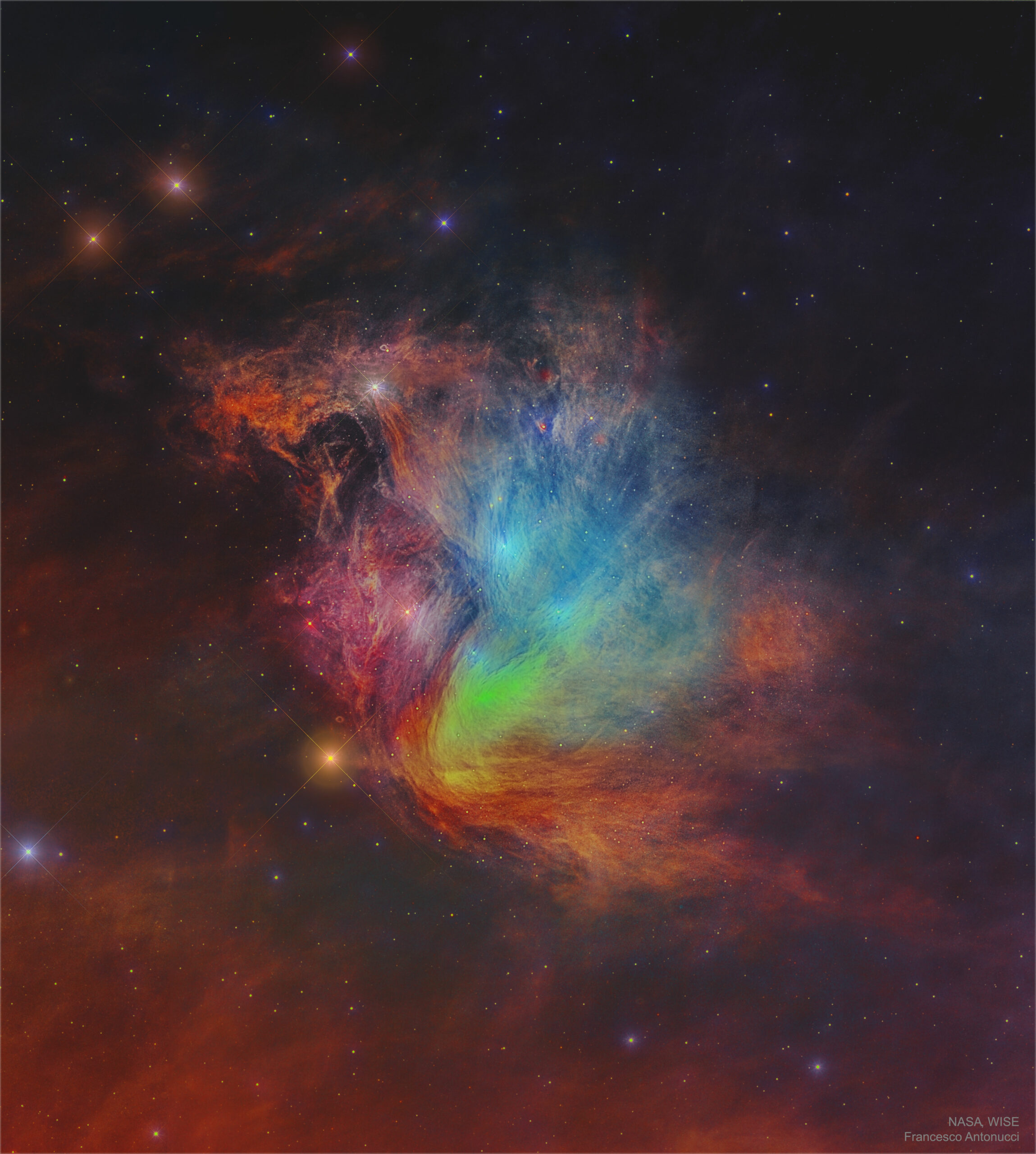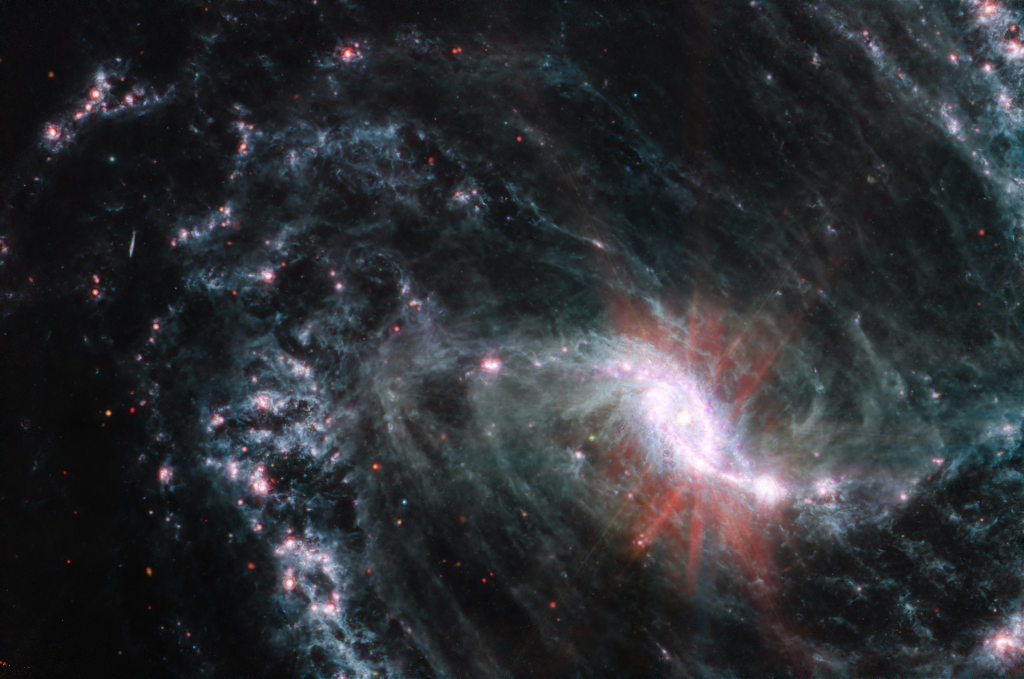Blog
A massive galaxy cluster in the constellation Cetus dominates the centre of this image from the NASA/ESA Hubble Space Telescope. This image is populated with a serene collection of elliptical and spiral galaxies, but galaxies surrounding the central cluster — which is named SPT-CL J0019-2026 — appear stretched into bright arcs, as if distorted by a gargantuan magnifying glass. This cosmic contortion is called gravitational lensing, and it occurs when a massive object like a galaxy cluster has a sufficiently powerful gravitational field to distort and magnify the light from background objects. Gravitational lenses magnify light from objects that would usually be too distant and faint to observe, and so these lenses can extend Hubble’s view even deeper into the Universe. This observation is part of an ongoing project to fill short gaps in Hubble’s observing schedule by systematically exploring the most massive galaxy clusters in the distant Universe, in the hopes of identifying promising targets for further study with both Hubble and the NASA/ESA/CSA James Webb Space Telescope. This particular galaxy cluster lies at a vast distance of 4.6 billion light years from Earth. Each year, the Space Telescope Science Institute is inundated with observing proposals for Hubble, in which astronomers suggest targets for observation. Even after selecting only the very best proposals, scheduling observations of all of Hubble’s targets for a year is a formidable task. There is sometimes a small fraction of observing time left unused in Hubble’s schedule, so in its ‘spare time’ the telescope has a collection of objects to explore — including the lensing galaxy cluster shown in this image. [Image description: A cluster of large galaxies, surrounded by various stars and smaller galaxies on a dark background. The central cluster is mostly made of bright elliptical galaxies that are surrounded by a warm glow.

John Warren Geils Jr. (/ɡaɪlz/) (February 20, 1946 – April 11, 2017), known professionally as J. Geils or Jay Geils, was an American guitarist. He was known as the leader of The J. Geils Band.
Growing up in New York City, Geils became interested in jazz and blues. After moving to Massachusetts for his college education, he formed the J. Geils Blues Band while still a student at Worcester Polytechnic Institute. After dropping the word “Blues” from their name, the band released their first album in 1970, performing soul and rhythm and blues-influenced rock music for most of the 1970s before turning to pop music in the 1980s. After the band broke up in 1985, Geils left regular performing to take up restoration and racing of automobiles, with occasional forays into music production. He continued to appear in reunion tours with the rest of his band sporadically during the 2000s and 2010s.
John Warren Geils Jr. was born on February 20, 1946, in New York City, and grew up in Morris Plains, New Jersey. He was of German ancestry.
more...Buffy Sainte-Marie, CC (born Beverly Sainte-Marie, February 20, 1941) is an Indigenous Canadian-American (Piapot Cree Nation) singer-songwriter, musician, composer, visual artist, educator, pacifist, and social activist. While working in these areas, her work has focused on issues facing Indigenous peoples of the Americas. Her singing and writing repertoire also includes subjects of love, war, religion, and mysticism. She has won recognition, awards and honours for her music as well as her work in education and social activism. Among her most popular songs are “Universal Soldier“, “Cod’ine“, “Until It’s Time for You to Go“, “Take My Hand for a While”, “Now That the Buffalo’s Gone“, and her versions of Mickey Newbury‘s “Mister Can’t You See” and Joni Mitchell‘s “The Circle Game“. Her songs have been recorded by many artists including Donovan, Joe Cocker, Jennifer Warnes, Janis Joplin, and Glen Campbell.
In 1983, she became the first Indigenous American person to win an Oscar, when her song “Up Where We Belong“, co-written for the film An Officer and a Gentleman, won the Academy Award for Best Original Songat the 55th Academy Awards. The song also won the Golden Globe Award for Best Original Song that same year.
In 1997, she founded the Cradleboard Teaching Project, an educational curriculum devoted to better understanding Native Americans.
Sainte-Marie was born in 1941 on the Piapot 75 reserve in the Qu’Appelle Valley, Saskatchewan, Canada, to Cree parents. At age two or three she was taken from her parents as part of the Sixties Scoop – a government policy where Indigenous children were taken from their families, communities and cultures for placement in non-First Nations families.
more...Frederick L. Robinson (February 20, 1901 – April 11, 1984) was an American jazz trombonist known for his work with Louis Armstrong and other jazz groups.
Robinson was born on February 20, 1901 in Memphis, Tennessee. Robinson learned to play trombone in high school. He studied at the Dana Musical Institute in Ohio.
more...Nancy Sue Wilson (February 20, 1937 – December 13, 2018) was an American singer and actress whose career spanned over five decades, from the mid-1950s until her retirement in the early 2010s. She was especially notable for her single “(You Don’t Know) How Glad I Am” and her version of the standard “Guess Who I Saw Today“. Wilson recorded more than 70 albums and won three Grammy Awards for her work. During her performing career, Wilson was labeled a singer of blues, jazz, R&B, pop, and soul; a “consummate actress”; and “the complete entertainer”. The title she preferred, however, was “song stylist”.She received many nicknames including “Sweet Nancy”, “The Baby”, “Fancy Miss Nancy” and “The Girl With the Honey-Coated Voice”.
Nancy Wilson was born on February 20, 1937 in Chillicothe, Ohio, to Olden Wilson, an iron foundry worker, and Lillian Ryan. Wilson attended Burnside Heights Elementary School and developed her singing skills by participating in church choirs. She attended West High School in Columbus, Ohio where she won a talent contest and was rewarded with a role as a host for a local television show. She then went on to attend Ohio’s Central State University where she pursued her B.A. degree in education.
more...Known for its iconic blue stars, the Pleiades is shown here in infrared light where the surrounding dust outshines the stars. Here three infrared colors have been mapped into visual colors (R=24, G=12, B=4.6 microns). The base images were taken by NASA’s orbiting Wide Field Infrared Survey Explorer (WISE) spacecraft. Cataloged as M45 and nicknamed the Seven Sisters, the Pleiades star cluster is by chance situated in a passing dust cloud. The light and winds from the massive Pleiades stars preferentially repel smaller dust particles, causing the dust to become stratified into filaments, as seen. The featured image spans about 20 light years at the distance of the Pleiades, which lies about 450 light years distant toward the constellation of the Bull (Taurus).

Robert Edward Rogers (February 19, 1940 – March 3, 2013) was an American musician and tenor singer, best known as a member of Motown vocal group the Miracles from 1956 until his death. He was inducted, in 2012, as a member of the Miracles to the Rock and Roll Hall of Fame. In addition to singing, he also contributed to writing some of the Miracles’ songs. Rogers is the grandfather of R&B singer Brandi Williams from the R&B girl group Blaque and is a cousin of fellow Miracles member Claudette Rogers Robinson.
Rogers was the son of Robert and Lois Rogers. He was born in Detroit on February 19, 1940, the same day and in the same Detroit hospital as fellow Miracles member Smokey Robinson, although the two would not meet until 15 years later.
On December 18, 1963, Rogers married Wanda Young of Inkster, Michigan, a member of Motown group the Marvelettes. Together they had a son Robert Rogers III and a daughter Bobbae. Rogers and Young divorced in 1975 after twelve years of marriage. In 1981, Rogers married Joan Hughes on his forty-first birthday. The wedding ceremony was officiated by the Reverend Cecil Franklin, the older brother of Queen of Soul Aretha Franklin at Detroit’s historic New Bethel Baptist Church. Bobby and Joan had two children together, daughters Gina and Kimberly. In his final years, Rogers divided his residence between his primary dwelling in Southfield, Michigan, a northern suburb of Detroit, and a Beverly Hills, California pied-à-terre.
The 1960 single “Shop Around“, with Smokey Robinson on lead, was Motown’s first number one hit on the R&B singles chart, and the first big hit for the Miracles. The song was also Motown’s first million selling hit single. The Miracles scored many more hits over the years including the #1 classics “Tears Of A Clown”, and “Love Machine”.
In addition to his work in the Miracles, Rogers was a part-time Motown songwriter; his most notable composition, authored with bandmate Smokey Robinson, was The Temptations‘ first hit single, “The Way You Do the Things You Do“. Rogers also co-wrote The Temptations’ 1965 hit “My Baby“, Mary Wells’ hit, “What Love Has Joined Together“, The Contours‘ 1965 hit “First I Look at the Purse“, (later covered by the J. Geils Band), Marvin Gaye’s 1966 Top 40 hit, “One More Heartache” and the Miracles’ own 1964 Top 40 hit, “That’s What Love Is Made Of“, and their 1966 hit, “Going to a Go-Go“. He is also noted for doing co-lead vocals on the Miracles’ 1962 Top 10 smash, “You’ve Really Got a Hold on Me“, and singing lead on the group’s 1964 song, “You’re So Fine And Sweet”. Bobby was also reputed to be the group’s best dancer, and was responsible for many of the Miracles’ onstage routines, until the arrival of famed Motown choreographer Cholly Atkins.
more...Louis “Kid Shots” Madison (19 February 1899, New Orleans – September 1948, New Orleans) was an American jazz cornetist.
Madison was born in New Orleans on 19 February 1899. He studied cornet under David Jones, Louis Dumaine, and Joe Howard. In 1915, he was the drummer in the Colored Waif’s Home band with Louis Armstrong. In 1923, he played second cornet with the Tuxedo Brass Band. During the 1930s, he played with the WPA brass band. In the 1940s, he played with the New Orleans Eureka Brass Band.
In January 1948, Madison suffered from a stroke and died eight months later.
more...
William “Smokey” Robinson Jr. (born February 19, 1940) is an American singer, songwriter, record producer, and former record executive director. He was the founder and front man of the Motown vocal group the Miracles, for which he was also chief songwriter and producer.He led the group from its 1955 origins as “the Five Chimes” until 1972, when he announced his retirement from the group to focus on his role as Motown’s vice president. However, Robinson returned to the music industry as a solo artist the following year. Robinson left Motown Records in 1990, following the sale of the company two years earlier.
Robinson was inducted into the Rock and Roll Hall of Fame in 1987 and was awarded the 2016 Library of Congress Gershwin Prize for his lifetime contributions to popular music.In 2022, he was inducted into the Black Music & Entertainment Walk of Fame.
William Robinson Jr. was born to an African-American father and a mother of African-American and French descent into a poor family in the North End area of Detroit, Michigan.Robinson’s ancestry is also part Nigerian, Scandinavian, Portuguese, and Cherokee. His uncle Claude gave him the nickname “Smokey Joe” when he was a child.
more...A mere 56 million light-years distant toward the southern constellation Fornax, NGC 1365 is an enormous barred spiral galaxy about 200,000 light-years in diameter. That’s twice the size of our own barred spiral Milky Way. This sharp image from the James Webb Space Telescope‘s Mid-Infrared Instrument (MIRI) reveals stunning details of this magnificent spiral in infrared light. Webb’s field of view stretches about 60,000 light-years across NGC 1365, exploring the galaxy’s core and bright newborn star clusters. The intricate network of dusty filaments and bubbles is created by young stars along spiral arms winding from the galaxy’s central bar. Astronomers suspect the gravity field of NGC 1365’s bar plays a crucial role in the galaxy’s evolution, funneling gas and dust into a star-forming maelstrom and ultimately feeding material into the active galaxy’s central, supermassive black hole.

Veronica “Randy” Crawford (born February 18, 1952 Macon, GA) is an American jazz and R&B singer. She has been more successful in Europe than in the United States, where she has not entered the Billboard Hot 100 as a solo artist. However, she has appeared on the Hot 100 singles chart twice. The first time was in 1979 as a guest vocalist on The Crusaders‘ top-40 hit “Street Life“. She also dueted with Rick Springfield on the song “Taxi Dancing”, which hit number 59 as the B-side of Springfield’s hit “Bop Til You Drop”. She has had five top-20 hits in the UK, including her 1980 number-two hit, “One Day I’ll Fly Away“, as well as six UK top-10 albums. Despite her American nationality, she won Best British Female Solo Artist in recognition of her popularity in the UK at the 1982 Brit Awards. In the late 2000s, she received her first two Grammy Award nominations.
more...
Sidney Thomas “Tommy” Boyce (September 29, 1939 – November 23, 1994) and Bobby Hart (born Robert Luke Harshman; February 18, 1939) were a American duo of singer-songwriters. In addition to three top-40 hits as artists, the duo is well known for its songwriting for The Monkees.
Hart’s father was a church minister and he himself served in the Army after leaving high school. Upon discharge, he travelled to Los Angeles seeking a career as a singer. Boyce was separately pursuing a career as a songwriter. After being rejected numerous times, Boyce took his father’s suggestion to write a song called “Be My Guest” for rock and roll star Fats Domino. He waited six hours at Domino’s hotel room to present him with the demo, and got Domino to promise to listen to the song. The song hit No. 8 in the US and No. 11 in the UK, becoming Domino’s biggest hit there in several years, and sold over a million copies.Boyce also found success as the co-writer, with Curtis Lee, of Lee’s 1961 hits “Pretty Little Angel Eyes” and “Under the Moon of Love“.
more...More Posts
- Happy Palm Sunday 2025
- MAGA Hocus Pocus
- Survival
- Plant Seeds
- Happy Passover 2025
- Stockholm Syndrome
- Eddie Marshall
- Cosmo Markarian’s Chain
- Jack Cassady
- Lowell George
- Al Green
- World Music Ebo Taylor
- Daily Roots Jacob Miller
- William Morris Society
- Hat of a Different Color
- Cosmo NGC 3169
- Herbie Hancock
- Shakey Jake Harris
- Hound Dog Taylor
- World Music ESINAM & Sibusile Xaba
